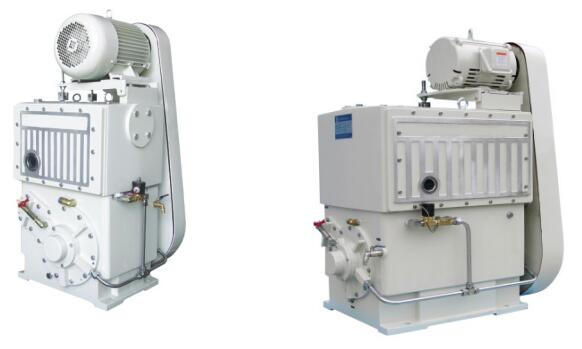Vacuum pump mechanical installation
Vacuum pump is a device that produces, improves and maintains vacuum in a closed space by various means. Vacuum pump can be defined as: mechanical, physical, chemical or physicochemical methods to be pumped by the container to obtain a vacuum device or equipment. With the development of vacuum applications, a variety of vacuum pumps have been developed, with pumping speeds ranging from a few liters per second to hundreds of thousands or millions of liters per second. Limit pressure (extreme vacuum) from coarse vacuum to over 10-12 Pa high vacuum range.
2H Piston Vacuum Pump
Technical Parameters:
| Model | Ultimate pressure | Pumping speed | Inlet diam | Outlet diam | Motor power | Cooling water consumption | weight | |
| Pa | Torr | L/s | mm | mm | kw | kg/h | kg | |
| 2H-15 | 6×10-2 | 4.5×10-4 | 15 | 50 | 40 | 2.2 | Air-cooling | 175 |
| 2H-30 | 6×10-2 | 4.5×10-4 | 30 | 63 | 50 | 4 | 100 | 380 |
| 2H-70 | 6×10-2 | 4.5×10-4 | 70 | 80 | 50 | 7.5 | 150 | 710 |
| 2H-120 | 6×10-2 | 4.5×10-4 | 120 | 100 | 80 | 15 | 200 | 960 |
| 2H-150 | 6×10-2 | 4.5×10-4 | 150 | 100 | 80 | 15 | 200 | 1020 |
Vacuum pump mechanical installation method:
1. Vacuum pump should be installed in a solid and solid place on the ground. There should be ample room around it for inspection, maintenance and maintenance.
2. The foundation level should be maintained under the vacuum pump base. The cushion damping rubber or bolt pouring installation should be recommended at the four corners of the base to ensure smooth operation of the vacuum pump and low vibration.
3. The connecting pipeline between vacuum pump and system should be sealed reliably. For small vacuum pump, oil-resistant rubber can be used to connect the sealing gasket with metal pipeline. For small vacuum pump, vacuum rubber tube can be used to connect the pipeline diameter should not be less than the suction diameter of vacuum pump, and the pipeline should be short and less elbow. The welding slag should be removed when welding pipeline, and welding slag should not be allowed to enter the vacuum chamber. )
4. In the connecting pipeline, the user can install valve and vacuum meter above the air inlet of vacuum pump, and check the limit pressure of vacuum pump at any time.
5. Connect the power supply according to the motor sign, and install the appropriate fuse and thermal relay.
6. When the vacuum pump is running on electric test, the motor belt must be taken off to confirm that the vacuum pump can be put into use in accordance with the prescribed direction in order to prevent the vacuum pump from reversing fuel injection. (steering according to the direction of protective cover).
7. For the vacuum pump with cooling water, the cooling water should be connected according to the regulations.
8. if the solenoid valve is installed at the vacuum pump port, the valve and the vacuum pump should act simultaneously.
9. When the gas discharged from the vacuum pump affects the working environment, the pipeline can be installed at the exhaust port to lead off or install the oil mist filter.
(The article comes from the Internet. If reprinting is not allowed, please contact our company to delete it.)

